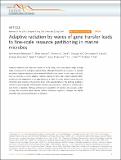Adaptive radiation by waves of gene transfer leads to fine-scale resource partitioning in marine microbes
Author(s)
Hehemann, Jan-Hendrik; Arevalo, Philip Alexander; Datta, Manoshi Sen; Yu, Xiaoqian; Corzett, Christopher H.; Henschel, Andreas; Preheim, Sarah P.; Timberlake, Sonia Crago; Alm, Eric J; Polz, Martin F; ... Show more Show less
DownloadPolz_Adaptive radiation by waves.pdf (1.397Mb)
PUBLISHER_CC
Publisher with Creative Commons License
Creative Commons Attribution
Terms of use
Metadata
Show full item recordAbstract
Adaptive radiations are important drivers of niche filling, since they rapidly adapt a single clade of organisms to ecological opportunities. Although thought to be common for animals and plants, adaptive radiations have remained difficult to document for microbes in the wild. Here we describe a recent adaptive radiation leading to fine-scale ecophysiological differentiation in the degradation of an algal glycan in a clade of closely related marine bacteria. Horizontal gene transfer is the primary driver in the diversification of the pathway leading to several ecophysiologically differentiated Vibrionaceae populations adapted to different physical forms of alginate. Pathway architecture is predictive of function and ecology, underscoring that horizontal gene transfer without extensive regulatory changes can rapidly assemble fully functional pathways in microbes.
Date issued
2016-09Department
Massachusetts Institute of Technology. Computational and Systems Biology Program; Massachusetts Institute of Technology. Department of Biological Engineering; Massachusetts Institute of Technology. Department of Biology; Massachusetts Institute of Technology. Department of Civil and Environmental EngineeringJournal
Nature Communications
Publisher
Nature Publishing Group
Citation
Hehemann, Jan-Hendrik, Philip Arevalo, Manoshi S. Datta, Xiaoqian Yu, Christopher H. Corzett, Andreas Henschel, Sarah P. Preheim, Sonia Timberlake, Eric J. Alm, and Martin F. Polz. “Adaptive Radiation by Waves of Gene Transfer Leads to Fine-Scale Resource Partitioning in Marine Microbes.” Nature Communications 7 (September 22, 2016): 12860.
Version: Final published version
ISSN
2041-1723